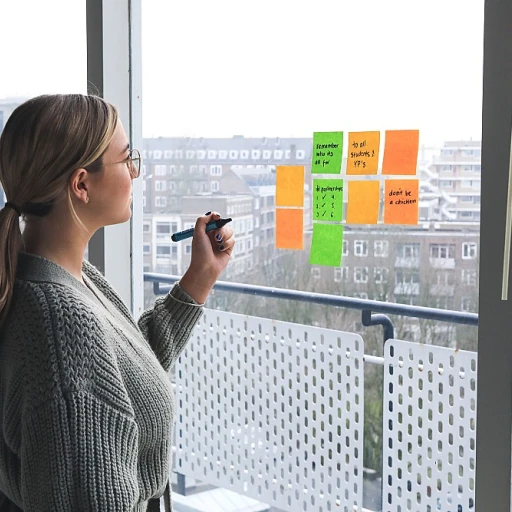Understanding the Design Process
Unpacking the Design Journey
The design process is the backbone of any company striving for innovative solutions. It begins with the initial conception and spans all the way through to the final product delivery. This journey can be complex, requiring a blend of creativity and structured project management to yield the best outcomes. Let's delve into the elements that constitute the design journey, which play a pivotal role in ensuring smooth transitions between various stages.- Conceptualization: This is where ideas are born, and the design team brainstorms to lay the groundwork for the project. It’s crucial to ensure that these embryonic concepts align with customer needs and business objectives.
- Planning and Development: Involves detailed planning and exploring how a concept can be realistically transformed. Here, project management practices come into play, aiding in organizing tasks and setting timelines.
- Design Execution: The practical phase where designs are created, refined, and tested. Efficient management at this stage ensures that the team promptly addresses any issues.
- Feedback and Iteration: No design journey is complete without feedback. It helps refine the product before the final release, thus contributing to higher customer satisfaction.
The Role of Ticketing Systems
Optimizing Collaboration and Efficiency
Effectively managing the design process within a company can be complex, and a robust ticketing system plays a pivotal role in streamlining operations. A ticketing system acts as a centralized platform where team members can log, track, and manage requests and tasks associated with various design phases. This ensures a smoother process flow, allowing the design team to remain focused on creativity and production. By utilizing ticketing systems, New Zealand companies can address both soft and hard data needs. For instance:- Facilitating customer support by efficiently managing customer service inquiries
- Streamlining internal requests and support tickets, ensuring quick resolution of issues
- Improving overall service management with real-time updates and notifications
- Enhancing team collaboration through seamless ticket management and sharing
Challenges Faced by New Zealand Companies
Addressing the Unique Hurdles in Aotearoa
In New Zealand, companies face a unique set of challenges when integrating ticketing systems into their design process. With the nation's distinct business culture and market dynamics, it is crucial to understand these obstacles to leverage the potential of ticket management systems effectively.
- Geographical Constraints: New Zealand's geographic isolation can pose difficulties in timely collaboration, particularly for international projects. The integration of a robust help desk system can facilitate seamless communication across borders, ensuring team members stay aligned.
- Resource Management: Many companies in New Zealand, especially SMEs, often operate with limited resources. Efficient service management systems are vital for optimizing the process flow, allowing for efficient resource allocation and project management.
- Data Collection and Analysis: Gathering and analyzing ticket data presents another hurdle. Accurate data is essential for improving customer satisfaction, but ensuring the data is comprehensive and actionable can be challenging without the right ticketing management software.
- Cultural Adaptability: New Zealand's diverse and inclusive work environments require ticketing tools that can easily adapt to varying cultural needs and preferences. This adaptability helps in providing top-notch customer support and achieving efficient issue resolution.
To overcome these challenges, employing best practices in workspace and system management is critical. By focusing on optimizing desk ticketing systems and enhancing the knowledge base available to the team, companies can improve their service desk effectiveness substantially. Investing the necessary time and effort into refining the ticketing process yields significant benefits, not only in tracking design phases but also in enhancing overall service quality.
Best Practices for Tracking Design Phases
Implementing Strategic Tracking with Ticketing Systems
In New Zealand companies, effectively monitoring the design process often involves strategic approaches to tracking phases. One way to achieve this is by utilizing ticketing systems that divide tasks into manageable units. These systems help optimize resource allocation and simplify project management.- Centralized Information: Use ticketing systems to house all relevant data in a centralized location, streamlining access for team members. Centralized service desks improve team transparency and cohesion.
- Consistent Communication: Encourage consistent communication pathways through support tickets and help desk functionalities. Regular updates keep everyone informed, reducing potential misunderstandings.
- Prioritization and Time Management: Applying tickets with priority labels helps teams focus on urgent issues. Teams can use time management tools within the ticketing system to track progress efficiently.
- Comprehensive Knowledge Base: Create a database of solutions for common problems with ticket management software. Team members can reference this knowledge base to solve issues quickly.
- Integration with Project Management Tools: Ensure that the ticketing process is integrated with existing project management tools. This integration helps synchronize efforts and ensures a smooth process flow.
Case Studies from New Zealand
Real-World Examples of Effective Design Monitoring
In New Zealand, several companies have successfully implemented ticketing systems to streamline their design processes. These case studies provide valuable insights into the practical benefits and challenges experienced in real scenarios. One prominent example involves a local tech firm that utilized ticketing systems to enhance their project management. By incorporating a ticket management system, the team significantly improved communication between team members and reduced the response time for support tickets. This efficiency led to higher customer satisfaction as service desk teams could effectively fulfill customer requests. Another New Zealand-based design agency opted for an integrated software solution to manage their process flow. This allowed seamless tracking of support tickets and facilitated better customer support by leveraging a comprehensive ticketing process. By adopting best practices in service management, they were able to identify common issues through ticket data analysis, leading to proactive problem-solving and faster resolution times. These improvements contributed to greater team cohesion and a more streamlined service desk operation. Lastly, a service-oriented business prioritized the use of a help desk system that provided a free trial to test different features. This approach enabled them to set up a robust knowledge base, where frequently asked questions and typical issues could be accessed by both customers and team members. As a result, the company managed to significantly reduce the volume of incoming help desk requests, enhancing customer service efficiency. Examining these New Zealand companies, it’s apparent that implementing a well-structured ticketing system not only optimizes the design process but also enhances overall project management and customer satisfaction. Learning from these examples can provide valuable insights for businesses looking to enhance their design monitoring techniques.Future Trends in Design Process Tracking
Emerging Trends in Design Process Monitoring
As New Zealand companies continue to navigate the complexities of design processes, several future trends are emerging that promise to reshape how teams manage and track these workflows. Understanding these trends can provide companies with a competitive edge, enhancing both efficiency and customer satisfaction.
1. Integration of AI and Machine Learning
The integration of AI and machine learning in ticketing systems is becoming increasingly prevalent. These technologies can analyze ticket data to predict potential bottlenecks and suggest process improvements. This not only helps in optimizing the process flow but also enhances the accuracy of project management.
2. Enhanced Collaboration Tools
Collaboration tools are evolving to support more seamless interaction among team members. Advanced ticket management systems now offer features that allow for real-time updates and communication, ensuring that everyone involved in the design process is on the same page. This can significantly reduce the time spent on resolving support tickets and improve overall efficiency.
3. Focus on Customer-Centric Design
There is a growing emphasis on incorporating customer feedback directly into the design process. Ticketing systems are being adapted to collect and analyze customer service requests and feedback, ensuring that design outcomes align closely with customer expectations. This shift towards a customer-centric approach is crucial for maintaining high levels of customer satisfaction.
4. Integration with Knowledge Bases
Linking ticketing systems with comprehensive knowledge bases is another trend gaining traction. This integration allows team members to access valuable information quickly, reducing the time needed to resolve issues and enhancing the service desk's efficiency. It also supports the development of a more informed and agile team.
5. Cloud-Based Solutions
The move towards cloud-based ticketing systems offers greater flexibility and scalability. These solutions enable teams to access the system from anywhere, facilitating remote work and ensuring that the design process is not hindered by geographical constraints. This trend is particularly relevant in the context of New Zealand's evolving work environment.
By staying abreast of these trends, New Zealand companies can ensure their design processes remain efficient and responsive to both team and customer needs. Adopting these innovations will likely become a key differentiator in the competitive landscape of design and service management.













